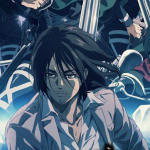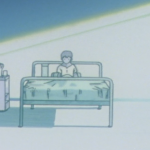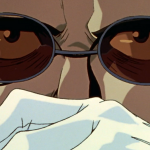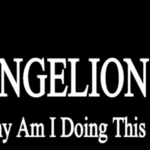Adios, Cowboy: Review 2 – Stray Dog Strut
In 1998’s Shakespeare in Love, Geoffrey Rush as Philip Henslowe offered what I believe to be a very honest observation on the contemporary audience: “Love and a bit with a dog. That’s what they want.”
With the central focus of this story on a Welsh Corgi, henceforth known as Space Doggo, my first instinct was to upload a bunch of animated gifs and write the words “Space Doggo” a few hundred times in varying-sized fonts. Why take such an action? First, and most critically, have you looked at this anime dog? I’ve lived with cats for so long I expect their DNA has started trying to rewrite my own, but even I think Space Doggo is adorable. Second, what possible critical discourse could I offer in this review that couldn’t be shut down with a cry of, “but, Space Doggo!?” Where would I go from there? Nowhere. That’s where. If you want to win an argument, yell Space Doggo at someone and see what happens.
Despite facing a Doggyashi Maru, I do wonder if there is some sort of long game I am missing within this story. Other than giving us what is quite likely the genesis point of the doge meme (a hat tip to Christina Vasilevski for coming to that thought before I did), what is this episode doing? Sure, it provides a wee bit more information on who Spike and Jet are as characters. I suppose it’s also important to know that a dog can upstage any dramatic tension a story cares to put forward. Still, Stray Dog Strut feels like an exercise in repetition, and we are only two episodes into the series.
Imagine the structure of Stray Dog Strut as embodied by two trains moving in opposite directions along the same track. The train marked “Spike and Jet” lumbers to life on the heels of the main characters watching Big Shot, a TV show that highlights the more notorious bounties at large in the solar system. Far off in the distance, another train marked “Abdul Hakim,” who is one of Mars’ most notorious pet thieves (yeah, pet thief, who knew that was a thing) is trying to fence an animal he stole from a research lab. Does any of this sound familiar to you? It should. Because this is how Asteroid Blues told its story.
On a contextual note, Big Shot seems to set the scope of the show within the Sol System. A further contextual question: how do a series of super-go-fast-rings work when planets have this nasty tendency to follow an orbit around the sun? Is there a lattice of super-go-fast-rings and super-go-fast-space in perpetual flux to keep up with the motion of the planets? If so, who is paying for such a thing?
Also, can you imagine the data art one could make by doing a time lapse of that lattice over a few decades?
Returning to the plot trains, the episode’s familiar tone builds as the trains collide a hair’s breadth before the end of the first act. This intersection of two otherwise independent stories is not owing to any clever twist of plot. Rather, the quintessential conflict of this episode occurs because Spike and Hakim are following their tracks to an inevitable ka-boom. They have no choice but to ram into each other at full stream.
What’s the angle here? Why do the same thing twice in the first two episodes? Why keep using deus ex machina to bring the two opposing plot threads together? Stripping the characters of their agency in Asteroid Blues was some unexpected Kung Fu Jazz. Here it is less of a surprise and more of a raised eyebrow.
Think about why Stray Dog Strut uses a street peddler with a psychic canary as the means of unifying Space Doggo, Hakim, and Spike. These characters are only meeting because the plot demands it. The writing does none of the work necessary to bring these characters together in a natural way. Thus, all that’s left to drive the story is plot magic. Yet the aesthetic is cool enough that the whole thing works. So for the life of me, I don’t know if this is supremely clever and in throwing out the routine of a Sam Spade-style story, or if razor-sharp execution is making up for narrative laziness.
Let’s consider a piece of what I believe to be Cowboy Bebop’s manifesto, as displayed, over and over, in the opening credits.
“The bounty hunters, who are gathering in the spaceship “BEBOP”, will play freely without fear of risky things. They must create new dreams and films by breaking traditional styles.”
In Asteroid Blues, we saw the mobilization of typical conventions, but their application was subverted through a lack of character agency. Stray Dog Strut doubles down on the format, showing characters, both bounty hunters and criminals, who are suffering the actions of the universe rather than being an active agents within it. So points to the writing for breaking traditional style. But do I like this approach? A subtext that frames life as nothing but a random series of chaotic events is a bit entry-level for my taste. Even Fight Club, the poster child for 90s alienation, did more with existential ennui than shrug and mutter shikata ga nai.
Great, now I can’t tell if I have a legitimate observation or if I’ve become a stuffed shirt who has problems accepting the avant garde because it is different and weird. Am I out of touch…no it’s the children who are wrong.
This brings me back to Kung Fu Jazz as a saving grace for the episode. Amid a caper that mobilizes bounty hunters, corporate security, a master thief, and then the two-bit punk who steals from the master thief, an adorable dog swaggers up the stage. The subsequent chase through the streets of Mars’ crater cities should be as serious an affair as it was in Asteroid Blues, but Space Doggo is constantly undermining the intensity. On top of that, Space Doggo gives Spike his first real moment of agency and character definition. In point of fact, it’s probably the only important thing the episode does.
The chase to catch Abdul Hakim builds to a decision gate. Spike can claim the ₩8,000,000 bounty on Hakim, or he can save Space Doggo from a painful death. For context, Spike reports that Hakim’s bounty would let him overhaul every system on the Bebop and still have enough left over to go for Peaking Duck. At the time of Stray Dog Strut, all the audience knows about Spike and Jet is that they are 0 for 1 on bounties and their ship is a piece of junk. Those observations might be enough to make someone see them as the virtuous and plucky underdogs, but I don’t see their roles as a foregone conclusion. For all we know Spike and Jet are anti-government, anti-establishment weirdos a la Firefly’s Malcolm Reynolds and Zoe Washburne.
Yeah, I went there. Every time you cheer for the Browncoats you are cheering for the space Confederacy. Think about your life choices.
Spike’s choice to give up a life-changing bounty, which he commits to in keeping Space Doggo aboard the Bebop rather than selling him back to the medical research company that created him, provides a clear answer to Mitchell and Webb’s now famous question, “Are we the baddies?” At worst, Spike is a chaotic good character. Whether this choice augurs his movement toward conventional hero status remains to be seen. If nothing else, we know he will save a dog.
Giving Space Doggo a home, however, doesn’t answer my question about repetition. Sure, we now know Spike probably a good egg. That is important. However, I still can’t see Cowboy Bebop’s game. Is there a bigger arc that is yet to be seen? Is this show going to be a series of one-offs that showcase stories that are as equally tight in their pacing as they are intentionally under-developed? Kung Fu Jazz is making the stories work, but it also makes the conflicts seem shallow amid settings that are obviously richly crafted. Maybe things were different in the 90s, but for me a show has to do more than flash its manifesto on the screen and then wink at the camera when does things in service of that manifesto. But hey, at least we got our bit with a dog, right?













